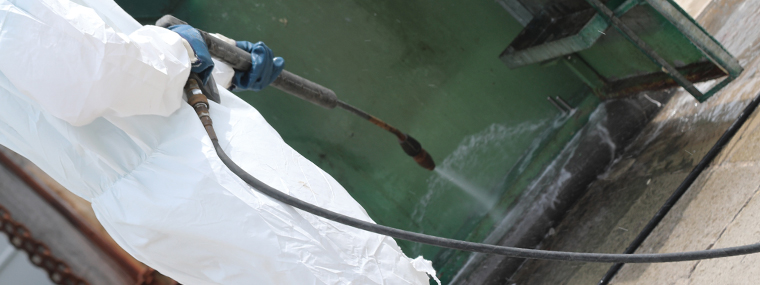
Troubleshooting Loss of Pressure
By Diane M. Calabrese / Published March 2022

Before running out to buy a new garden hose, we verify that any precipitous loss of pressure is due to a rupture and not to a kink. Troubleshooting instructs.
True, sometimes we identify genuine trouble. When we get nothing except a drip of water from an indoor spigot, we fear the worst: a broken pipe. The good news is it might be a water main break and a general disruption.
Whatever the reaction a loss of pressure brings to a contractor, doing an assessment makes sense. The loss could be due to something simple.
In addition, troubleshooting goes hand in hand with knowing the inner workings of a piece of equipment. A contractor may not be able to fix the problem with a machine, but there’s understanding gained in the effort.
“I can’t think of a reason not to troubleshoot any issue,” says Mike Hansen, sales manager—water division, Dultmeier Sales in Omaha, NE. He offers tips for getting started on the loss of pressure question.
“Pressure loss can occur from a wrong nozzle size, a worn nozzle, worn pump seals, worn pump valves, foreign particles trapped in pump valves, a relief/unloader valve malfunction, or pump starvation from a water supply,” says Hansen.
“Immediate pressure loss could be an issue with a valve or valves in the pump—or a seal issue in the pump,” says Hansen. “It could also be a relief valve/unloader valve malfunction or a water supply issue in the pump.”
When loss of pressure occurs, assessment ought to precede action. The biggest mistake a pressure-washer operator makes when there’s a loss of pressure is “turning the regulator or relief valve tension spring tighter than the original or correct setting,” says Hansen.
Have confidence that troubleshooting is doable. “Pressure washers by their nature are not very complex pieces of equipment, but they can be pretty intimidating,” says Derek Majewski, CFPS, marketing and business development specialist at Cat Pumps in Minneapolis, MN.
Set appropriate limits to err on the side of solving the problem and not creating a new one. “Many initial troubleshooting steps are relatively quick and straightforward,” says Majewski. “Still, if the pump needs to be disassembled, less-experienced users may feel more comfortable having a professional inspect, test, and repair the pump.”
Just how did the pressure loss occur? Suddenly? A steady change over time?
“If the pressure loss was sudden, external accessories like an easy-start valve could be the cause and are usually an easy fix,” says Majewski. “A quick tap to the easy-start valve may free the internal ball if it sticks. If that doesn’t help, disassembling, cleaning, and reassembling may resolve the issue.”
And if the foregoing does not bring the pressure back? “The last resort is to remove the easy-start valve from the system and plug the ports where it plumbs into the pump,” says Majewski.
Majewski suggests some other components to check, too. “Other quick assessments could include checking for a worn nozzle(s), air leaks in the inlet plumbing, a malfunctioning pressure gauge, a clogged or improperly sized inlet suction strainer—filter, a leaky discharge hose, or an inadequate liquid supply.”
Sometimes, the problem does reside in the pump. If so, it will require the attention of an expert in pump function and maintenance. (In some instances, it may be the contractor.)
“If the pressure loss has been getting more severe over time and there is an external leak between the pump manifold and crankcase, there might be damage to the pump seals,” says Majewski. “The pump should be dis-assembled and inspected by a qualified technician. Other parts may need to be replaced along with the seals.”
Whatever is going on and contributing to the loss of pressure, attempting a quick fix without identifying a specific issue is not the way to go. That cannot be stressed enough, so we reemphasize a point made earlier.
“One common mistake is to try to boost the pressure by increasing the pressure setting of the unloader valve,” says Majewski. “If the seals or nozzle are worn, adjusting the unloader will not help to raise the pressure. Instead, it will create pressure spikes when the trigger is released and can cause damage to the unloader piston and seat.”
Customer Q&A
Veteran contractors have a good understanding of their equipment. Without that knowledge, they would not build successful companies, a result hinging in part on purchasing the best machines for the type of work being done.
Novice contractors and home-owners who get involved with pressure washers often have a lot
of questions when something goes awry. Raj Trivedi, Comet’s key account manager at Valley Industries in Paynesville, MN, tells us the sorts of questions to which he responds—and the types of questions he asks.
First, Trivedi warns that there are two instances in which an operator should not try to sort through the loss of pressure. They are “when the unloader or pump is either known to be defective—leaking/cracked—or when there is clear evidence that the machine overheated…” That evidence could be a machine left unattended that ran dry.
If neither of those cases applies, it’s on to questioning the customer to get a full description of the pressure loss. “Firstly, I ask them to look for inlet leaks and, if there are none, have them then disconnect and check the inlet filter for contaminants, etc…Then, I make sure the unloader is turned clockwise.”
From there, Trivedi asks questions that could yield valuable insight into the problem but sometimes do not. For instance, he asks the customer to tell him the tip color and attempts—not always successfully with a new user—to get the tip size.
After that? “I ask them to hold the tip to the sky and check for partial blockage, then re-prime the system for three minutes and retest,” says Trivedi.
“Next, I ask if they are using three-quarter inch garden hose—all machines three gpm or more [are so] required by manufacturers—and verify that it is under 100 feet,” explains Trivedi. “Then, I have them do a bucket test.”
The bucket test allows Trivedi to learn how many gallons flow out of the hose in one minute. The gallons at the end of the hose in a minute’s time should be one and one-half to two times the pump gpm. If that all checks out, he asks the customer to bring the machine to the service center.
When there is a sudden loss of pressure, Trivedi asks the customer to check to see if the pump is rotating. “The drive key can fall out or shear,” he explains. “If it’s turning, check the inlet filter, prime for three minutes, and retest to rule out an air pocket in the pump. If that fixes it, then the garden hose issues need resolving.” (And it’s back to the bucket test.)
Assumptions put the owner of a pressure washer at risk of making a small problem worse. New owners too frequently jump to a solution when they do not know the problem. “They assume they have bad seals and take the machine apart, or go on Amazon and order a packing kit, assuming before disassembly that it was bad seals,” says Trivedi.
Included in other mistakes, says Trivedi, are several worth repeating (from above). They are “not adjusting the unloader; failing to check the unloader; and failing to check filters, leaks, water supply, and nozzles.”
Occasionally customers who do not have a basic knowledge of pressure washers will not like the questions or the advice. “I lost a big customer because I informed him he could not use 700 feet of garden hose,” says Trivedi.
The entire purpose of trouble-shooting, though, is to zero in on the problem so it can be fixed. And to learn much more about the machine in the process.
“Regular pump oil changes, regular filter cleaning, regular tip/nozzle replacement, reduced bypass times, and relieving the pressure once the unit is turned off” are reminders Trivedi knows experienced operators know well. The key is to follow them.
And while we are on the list of basics, Trivedi adds just a few more: Make sure the inlet filter is present and clean. Prime the pump for three minutes before starting work. Do not let the machine run “unattended” or without spraying the trigger. Match tip and hose length to physical capabilities of the machine.
The Pump Matters
Scrupulous attention to the basics ensures that a loss of pressure will indicate something minor that can be corrected easily. Start skipping the routine maintenance and prepping of a pressure washer and put it on a path toward failure that could involve a catastrophic loss of pressure because of pump damage.
Keep contaminants out of the pump. Follow all the manufacturer’s instructions for changing filters and oil. Before each use, run water until it runs clean. Don’t let the pump run dry, which causes overheating.
Thermal strain shortens the lifespan and diminishes the performance of a pump. When a pump is under strain, it may vibrate more than anticipated by the design of the machine it supports. That puts a strain on other components such as seals, couplings, etc.
Every pump has an optimal performance point for a specific temperature and flow. Pushing it outside its limits or being inattentive to fouling (contaminants) can lead to cavitation and failure of the pump.
The good news is that much more pressure loss stems from clogged nozzles and unloaders than complete pump failure. One clue to a nozzle issue is an unfamiliar spray pattern. Look for debris in the nozzle. (And do doublecheck, even if a veteran of the industry, that the wrong size nozzle has not been attached.)
Machines designed for top performance incorporate engineering features to reduce the number of junctures at which trouble can erupt. Designs that minimize turns through filters and fittings, for one, enhance the longevity of seals (aka packings) and check valves. Buying a machine from a manufacturer with a strong track record is a good idea.
As much a learning experience as troubleshooting loss of pressure is, often the best way to accurately assess and remedy the problem is to take the machine to a service center. Correctives—even just new seals—will be done faster and exactly right.
When pressure obtained from a machine is the pressure expected, it’s a signal that the proper maintenance has been done. If there is a loss of pressure in a machine, resolve the issue. From there on, focus on doing everything on the routine maintenance schedule without fail.






